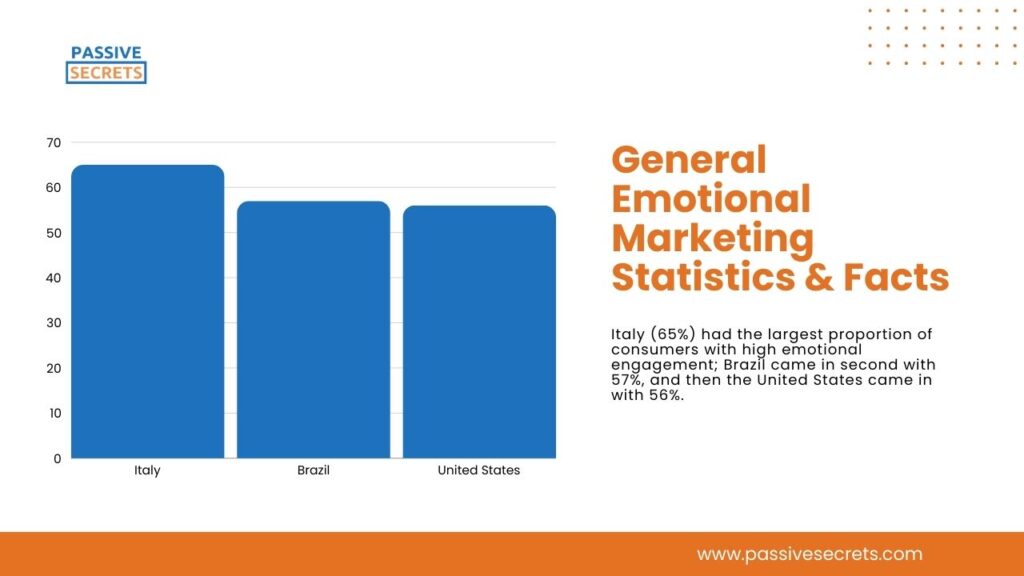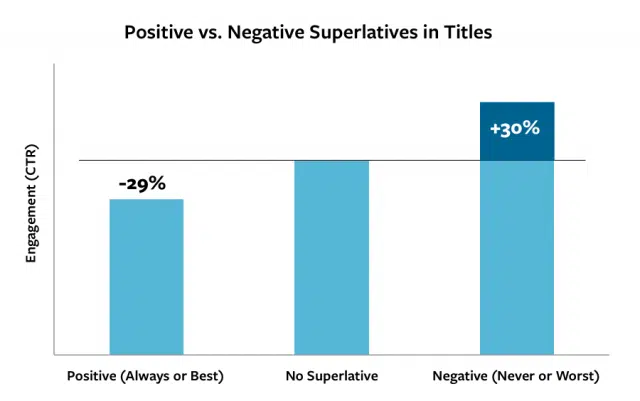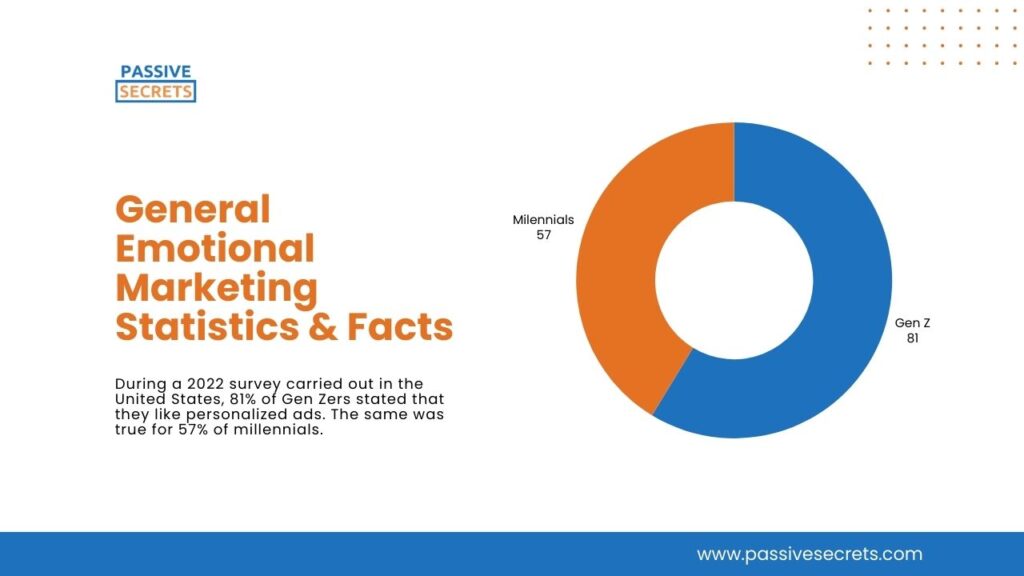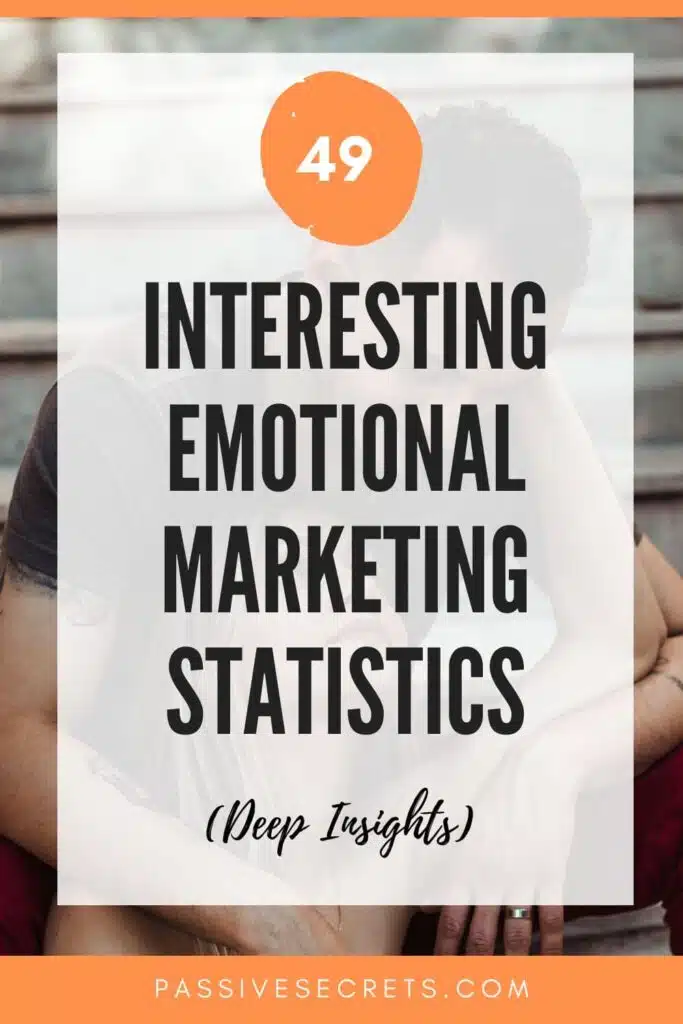
Our emotions are very powerful.
Understanding your emotions is crucial for marketing success. Unfortunately, only a few marketers know this secret and use it to their advantage.
Emotional marketing taps into the feelings and experiences that shape consumer behavior, transforming campaigns from ordinary to extraordinary.
In this article, we’ll explore a collection of compelling emotional marketing statistics that every marketer should know.
Discover how emotional ads boost sales, and emotional brand connections increase customer lifetime value, inspiring you to refine your marketing strategies for deeper audience connections.
Key Emotional Marketing Statistics (Editor’s Pick)
- 70% of consumers will most likely buy a product after being emotionally triggered by an advertisement.
- 71% of customers suggest a brand because they have an emotional connection to it.
- Emotional marketing efforts have a success rate of 31%.
- 70% of decisions are made based on emotions.
- Happiness is the most widely used emotion in advertising.
- Ads portraying above-average emotional responses have a 23% potential sales increase.
- 55% of adults claimed that a business being located in their area made them feel emotionally connected to it.
General Emotional Marketing Statistics & Facts
1. 70% of consumers will most likely buy a product after being emotionally triggered by an advertisement. (source)
2. 71% of customers suggest a brand because they have an emotional connection to it. (source)
3. Approximately 80% of emotionally engaged customers say that price competitiveness, promotions, and instant customer service are important factors when deciding which brand to be loyal to. (source)
4. 70% of emotionally engaged consumers say that certain brand values, such as being socially responsible or environmentally friendly, are important. (source)
5. Emotional marketing efforts have a success rate of 31%. (source)
6. According to Gallup research, 70% of decisions are made based on emotion, including brand preference. (source)
7. Consumer groups between the age of 22-36 prioritize emotions over rational factors and brand values. (source)
Consumers between the ages of 37-52 prioritize rational factors over emotions and brand values. Lastly, age groups between 53-71 prioritize brand values over emotions and rational factors.
8. Customers who are emotionally engaged are three times more likely to promote products to others. (source)
9. Happiness is the most widely used emotion in advertising. (source)
10. Italy (65%) had the largest proportion of consumers with high emotional engagement; Brazil came in second with 57%, and then the United States came in with 56%. (source)

11. Millennials between the age of 18-21 comprise the largest proportion (58%) of consumers with high emotional engagement next to 22-36 (57%) and 37-52 (46%). (source)
12. Urban locations comprise the largest proportion of consumers (53%), suburban consumers (45%), and rural consumers (42%) with high emotional engagement. (source)
13. A majority of optionally engaged consumers (86%) expect a brand to show how it is loyal to them, regardless of participation in a formal loyalty program. (source)
14. 54% of consumers had low emotional engagement when it comes to brand loyalty. (source)
15. 69% of emotionally engaged consumers want the brand to play a greater role in their lives. (source)
16. 80% of consumers expect brands to know their individual preferences on a personal level, while 21% of consumers have no expectations whatsoever. (source)
17. 90% of consumers want real-time responses and speedy resolutions from brands that they are loyal to. (source)
18. 83% of consumers want multiple ways to interact with brands to fulfill their requirements. (source)
19. 79% of consumers expect a differentiated shopping experience compared to someone who is not loyal when contacting customer service. (source)
20. The global emotional analytics market is estimated to grow at a CAGR of 82.9% by 2022. (source)
21. 48% of consumers are emotionally connected when shopping online, which is often thought of as a shopping experience with less human characteristics. (source)
22. Fewer consumers (43%) associate high emotional engagement with home furnishing and electronics. (source)
23. Total ad spend by consumers with very high emotional engagement moved from $1.60 billion to $1.75 billion. The total ad spend by consumers with low emotional engagement was $1.16 billion. (source)
24. Emotional engagement with customers could drive a 5% uplift in annual revenue. (source)
25. Emotional marketing can lead to a 40% increase in new account growth. (source)
26. 86% of consumers claim to always think of the brand that they are loyal to when they need something in that product/service category, while 56% do not. (source)
27. 81% of emotionally engaged consumers enjoy giving back to a brand just as much as they receive from the brand, while 37% do not. (source)
28. Research has shown that customers can be made to engage emotionally by focusing on the “4 Rs”: Respect, Reciprocate, Recognize, and Reward. (source)
29. Campaigns with purely emotional content performed about twice as well (31% Vs. 16%) with only rational content. (source)
Those campaigns that were purely emotional did a little better (31% vs. 26%) than those that mixed emotion and rational content.
30. Portuguese social advertising campaigns prioritize rational appeals, emphasizing logic, facts, awareness, and solutions. (source)
31. The use of a rational tone is more effective when it comes to emotional marketing among older audiences. (source)
32. Ads portraying above-average emotional responses have a 23% potential sales increase. (source)
33. Compared with headlines that contained neither positive (“always” or “best”) nor negative (“never” or “worst”) superlatives, headlines with positive superlatives performed 29% worse, and headlines with negative superlatives performed 30% better. (source)

34. The average click-through rate on headlines with negative superlatives was a staggering 63% higher than that of their positive counterparts. (source)
35. During a 2022 survey fielded in the United Kingdom, gauging their perception of advertising, 47% of people said they found advertising that made them feel emotional on TV. Social media ranked second, and 17% of the interviewed consumers named it. (source)
36. Also, 34% of respondents stated that they trusted TV. Cinema and the radio ranked second, both trusted by 32% of interviewed consumers. (source)
37. When advertising on digital media, eliciting an emotional response in the brief window captures clients’ complete attention and increases brand memory by 20%. (source)
38. Purchased decisions are driven by emotion as much as by intellect. (source)
Your brand must reach people’s hearts and make a meaningful, emotional connection in order to be effective. This is because your brand needs your prospective customers.
39. Marketing strategies that do not focus on stimulating clients’ emotions have an 80% likelihood of creating doubts in their thoughts.. (source)
40. 55% of adults claimed that a business being located in their area made them feel emotionally connected to it. However, 14% of adults claimed that nothing would make them emotionally connected to a company. (source)
41. During a survey conducted in France, Germany, the United Kingdom, and the United States in September 2021, about 52% of responding adults claimed that a friendly and helpful approach made a great customer experience. This includes quickly answered questions. (source)
42. Between January and September 2023, the most prevailing emotion in Instagram posts relating to selected beauty brands (Anastasia Beverly Hills, Benefit Cosmetics, Fenty Beauty, Huda Beauty, Rare Beauty, and Too Faced) was joy—with 78.3% of posts expressing this emotion. (source)
Sadness was also measured as a social emotion in connection to Instagram beauty brands, with a significantly lower share of 4.9%.
43. During a 2022 survey carried out in the United States, 81% of Gen Zers stated that they like personalized ads. The same was true for 57% of millennials. In general, the share decreased with the increasing age of the respondents. (source)

44. In another survey conducted among loyalty program decision-makers worldwide, 14.5% of people classified their program as more emotional than rational. (source)
On the other hand, 65.4% of people described their program as being more rational than emotional.
45. During an early 2022 survey conducted among loyalty program decision-makers in Europe, 15.6% of respondents classified their program as more emotional than rational. 84.4% of people, on the other hand, described their program as more rational than emotional. (source)
46. 47% of people claimed that advertisements on TV made them feel more emotional, and 17% of people claimed that social media advertisements made them feel more emotional. (source)
47. There is a likelihood of shopping when feeling different emotions in the United States. Statistics have shown that people were 3.9× more likely to make purchases when they were extremely happy. (source)
48. Emotions tend to drive decision-making more than logic does. According to research, it is usually not about what the customers think but how they feel.
Therefore, emotionally charged words and scenarios that resonate with the audience should be used. (source)
49. In a recent report, we found that 69% of people said B2B purchasing is just as emotionally driven as B2C. (source)
Conclusion
As we have seen from the vital emotional marketing statistics, the power of emotions can transform your marketing strategies and build lasting connections with your audience.
Tapping into the human experience and creating campaigns that resonate on a deeper level drives sales, increases customer loyalty, and builds a lasting brand.
Use these emotional marketing insights to create inspiring campaigns that connect with consumers and leave a lasting impact.
Frequently Asked Questions
1. How can a brand successfully utilize emotional marketing?
Brands can successfully utilize emotional marketing by understanding their audience’s needs, aspirations, and emotional triggers. Brands can then create authentic stories and messages that resonate emotionally with their target audience.
2. Why is emotional marketing effective?
Emotional marketing is effective because emotions have a powerful influence on human decision-making. Emotional messages are more likely to capture people’s attention and break through the clutter of marketing messages. It also sticks in people’s memories, making them more likely to remember a brand or product.
Lastly, emotional marketing appeals can persuade people to take action, whether that’s making a purchase, sharing a post on social media, or recommending a product to a friend.
3. What’s an example of a successful emotional marketing campaign?
A famous example of a successful emotional marketing campaign is Nike’s “Just Do It”. The campaign managed to tap into the emotions of being a determined customer, which is also very inspiring to many people.

Other Interesting Marketing Statistics Posts You Shouldn’t Miss:
- B2B Sales Statistics: Latest Insights and Trends
- 50+ Essential Traditional Marketing Statistics & Trends
- 60+ QR Code Statistics, Usage, Forecasts & Trends
- 90+ Useful Marketing Jobs Statistics & Facts (Latest Report)
- Sales Enablement Statistics: Data You Need to Drive Sales Growth
- In-store vs Online Shopping Statistics And Analysis
- Social Media Addiction Statistics
- Latest In-Game Advertising Statistics
- From Passion to Profit: 120+ Creator Economy Statistics
- 80+ Big Marketing Software Statistics
- 45 Interesting Healthcare Marketing Statistics & Trends
- Print Marketing Statistics: Ad Spending, Market Size, & More
- Key Short-Form Video Statistics and Trends You Should Know
- 90 Amazing Millionaire Statistics
- 70+ Top Law Firm Marketing Statistics & NEW Trends
- Millennials on Social Media Statistics
- 23 Most Interesting First Impression Statistics To Know
- 60+ Interesting Storytelling Statistics, Facts & Huge Trends
- Amazon Book Sales Statistics: Intriguing Numbers and Facts
- 61+ Useful Podcast Advertising Statistics And Trends
- 50+ Useful Call Center Statistics And Trends
- 50 Crucial Amazon Advertising Statistics & Trends
- 65+ Must-Know Pay-Per-Click Statistics
- 40+ Interesting Omnichannel Marketing Statistics & Trends
- Multi-Level And Network Marketing Statistics, Facts & Trends
- Virtual Event Statistics & Benchmarks For Marketers & Organizers
- 55 Interesting Direct Mail Marketing Statistics and Trends
- B2B Lead Generation Statistics, Facts, Trends, Benchmarks, & Market Size
- 52 Valuable Trade Show Statistics and Trends
- 100+ Top Digital Marketing Vs. Traditional Marketing Stats
- 110+ Important Social Media Advertising Statistics & Trends
- 50 Interesting Organic Vs. Paid Search Statistics To Know
- 41+ MOST Important Copywriting Statistics To Know
- 80+ Useful Sales Funnel Statistics & Conversion Rates
- 40+ Latest Multi-Channel Marketing Statistics & Huge Trends

